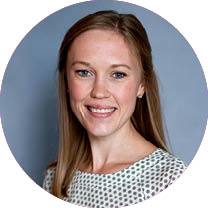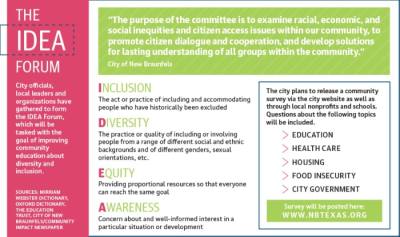In early September, complaints came before New Braunfels city officials regarding two incidents that sparked tension within the community.
One involved an offensive billboard located outside city limits on I-35 that bore a derogatory statement, and the other centered on photos from a local Trump Train event depicting a Black Lives Matter flag being dragged on the ground behind a truck.
Both incidents prompted statements and intervention from City Manager Robert Camareno and Mayor Rusty Brockman.
“In recent days, New Braunfels has experienced divisiveness. Some members of our community have felt attacked, demoralized, misunderstood, and concerned,” Brockman, who would not comment further, wrote in a Sept. 9 statement regarding the weekly Trump
Train events. “While all individuals and groups have the right to freedom of speech and to peaceably assemble, in New Braunfels, we expect that it is done in a lawful, safe, peaceful, and respectful manner.”
Camareno’s office stated in mid-September they had alerted the billboard company, which, in turn, removed the offensive statement.
While neither event was directly connected to the city’s recent actions to address diversity and inclusion within the community, both are examples of what area officials have recently been working to abate.
Since June, leaders from the city of New Braunfels, Comal ISD, New Braunfels ISD and other local organizations have created committees that have been meeting monthly to determine the best methods of addressing the needs of a local population that is not growing any less diverse.
For the most part, there are not yet defined timelines or established next steps planned for many of the tolerance initiatives being built through local entities. However, as meetings progress and committee members continue to solidify ideas, the community will have opportunities to give input and participate in the efforts.
“I feel like we could do better, but I certainly feel like we could do a lot worse,” lifelong New Braunfels resident Tiffany Quiring said. “Sometimes, I feel like we miss opportunities to do better because we’re so focused on holding tight to our tradition instead of just loving the person on the other side.”
A rapidly growing community
In 2019, New Braunfels was ranked as the third fastest-growing city in the United States, and between 2010 and 2018, the city grew by 20,515 residents, 40.14% of whom identify as people of color, according to the U.S. Census Bureau.
The population of New Braunfels surged past 90,000 this year, and Tiffany Quiring, the outreach and development director of River City Advocacy, said that as the city has grown, she has witnessed the community gradually become more accepting of new perspectives brought by new residents.
After the death of George Floyd in Minneapolis on May 25, demonstrations took place throughout the country, including in New Braunfels, with participants urging officials to address systemic racism and under-representation for people of color.
Marches held in New Braunfels on June 2 and 6 led local leaders to gather to pray and discuss how to address concerns surrounding racism, according to Bishop Michael Franklin, president of the New Braunfels Martin Luther King Jr. Association.
“New Braunfels is a city that has a history that could come back to bite them if we’re not prepared to deal with it, especially at this time, with the rise of tension when it comes to systemic racism and things of that nature,” Franklin said.
Forum created to address inclusion
Recent incidents in concert with other related situations have highlighted the need for ongoing conversations about diversity and inclusion, Franklin said.
“New Braunfels is very adamant of wanting to do something about ensuring that our city remains unified and that we be prepared to address any major concerns that may arise,” Franklin said. “We want to already have a good working team together so that when these things do happen here, we will be a step or two ahead of the game.”
In June, Brockman began holding monthly meetings with members of the MLK Association, the superintendents of New Braunfels and Comal ISDs, the New Braunfels Police Department, the Comal County Sheriff, the Hispanic Business Alliance and other local leaders to form a diversity and inclusion council.
The city also hired Dr. Richard Lewis, Ph. D., a professor of sociology at the University of Texas at San Antonio who specializes in diversity management and public administration, to help pinpoint areas in the city that need improvement.
“We came up with quite a long list of things after Dr. Lewis surveyed us that show that there might be some missing pieces to how New Braunfels is handling this faster growth,” Brockman said.
Brockman said Lewis will continue to be involved in the group’s planning and research efforts.
During an Oct. 8 meeting, the group was formally named the IDEA Forum; “IDEA” stands for “inclusion, diversity, equity and awareness.”
The forum plans to examine racial, economic and social inequities, and citizen access issues, and it will promote dialogue within the community, Franklin said.
“This is not something where we get to a finish line, give ourselves a blue ribbon and say, ‘OK, we’re done. Look at us.’ ... This is a long-term effort,” Brockman said. “It will be a living group that will continue to work to be able to understand our community through the eyes of so many diverse individuals that will continue to move here.”
School districts respond to racial diversity concerns
At NBISD, equity and inclusion goals have been included in plans for attendance zones and new facilities since 2007, according to Superintendent Randy Moczygemba.
The district has developed a program called Empower Hour at New Braunfels High School, which, according to Kara Bock, NBISD assistant superintendent of curriculum and instruction, encourages students to develop a positive culture in the school by focusing on kindness, compassion and relationship-building.
While NBISD officials have stated they are not creating any new initiatives beyond what already exists, Comal ISD has begun working to address diversity and inclusion concerns at the campus and district level.
Community demand for CISD to address racial diversity concerns came at the heels of an insensitive email sent Aug. 17 by CISD board President David Drastata to Canyon High School’s athletic booster club parents, in which Drastata referred to COVID-19 as “the China virus.”
The pejorative reference sparked concern among parents, teachers and students, who said they believe the term is racist and could lead to animosity toward those of Asian descent.
“I felt that if the board president could use a slur like this so lightly—that it would probably mean other people in the community are referring to the virus this way, too,” said CISD parent Morena Hockley, whose husband is Filipino-American and whose sons are student athletes at Canyon High School.
On Aug. 27, Drastata apologized on the Canyon Athletic Booster Club website. Hockley said the incident, along with insulting comments left by a CHS teacher on a Facebook post she made to express her worries, prompted her and other parents to share their experiences with the community and school board during the public comment portion of CISD’s Sept. 10 meeting.
“When parents have gone to the administration, they’ve been told it was just a joke or they were just kidding,” Hockley said. “[Students] keep getting the benefit of the doubt, but kids of color aren’t getting the same treatment.”
The student population at CISD has been trending more diverse in the last decade. Data from the Texas Education Agency shows that white students made up 57.76% of the CISD student population in the 2011-12 school year, nearly 5% higher than the 2018-19 school year.
In response to parent and community concerns, CISD Superintendent Andrew Kim said the district is in the process of creating an advisory committee on student inclusion, equity and diversity.
“The way I would like to approach this is not necessarily a quick reaction; rather, [it would be] a sustained, long-term work,” Kim said. “I think if we are really intending on doing this right, then we are going to have to take these incremental steps going forward, and hopefully, we can accelerate that as we get ourselves together in terms of how we want to structure [the council].”
Kim said he has begun conversations with district staff, teachers and board members to pinpoint key concerns among families and students in order to begin planning districtwide and campus-level solutions, but there is not yet a clear timeline for next steps. Franklin also joined the superintendent’s council and said the group has met several times since September.
On Sept. 11, Hockley attended the first meeting of the Comal High School Diversity Council, at which parents and student leaders met to discuss how to make the campus more inclusive. Planning for the group has moved slowly, Hockley said, but she remains hopefulthat it will continue to grow.
“As far as the board and the district, I would love to see them be more open with their thought process and their planning,” Hockley said. “Adding the issue of diversity to a future board meeting so that people know that’s on the agenda and they can come speak on it would help a lot.”
Dr. Jessica Edwards, whose stepsons are Black students at CHS, said she believes creating support networks for all minority groups in the school district and the community would be the most effective way to overcome issues.
“Having that supportive environment, I think, does more than even having a diversity director,” Edwards said. “I don’t think it just falls with education. It falls with almost every sector, and so that’s why the Diversity Council is working on trying to come up with how [we can] figure out what the best practices are.”







